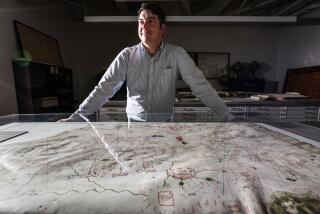TV REVIEW : Columbus as Con Artist in ‘Voyage’
- Share via
This has certainly been a year of re-evaluation of Christopher Columbus, the man who discovered or ruined the New World, depending on your point of view.
The documentary “Voyage of Mystery” (Channels 4, 6 at 7 p.m. Sunday) raises new questions about the accepted version of Columbus’ first voyage and, if its assumptions are correct, paints Columbus as a scheming and driven man, the perfect 15th-Century robber baron.
“Voyage of Mystery” tells of the research of Luis Coin, a scholar at Cadiz University in Spain, who believes that Columbus sailed a different route than now believed, falsified his logs and, in effect, stole the New World from Portugal and for Spain.
According to a treaty of the time, all discoveries made north of a horizontal line that ran just south of the Canary Islands were to belong to Spain. Everything to the south of the line was to belong to Portugal.
According to Keith Morrison, the host of “Voyage of Mystery,” Columbus is widely believed to have sailed due west from the Canary Islands and reached the New World in October, 1492.
Coin, however, believes that once Columbus left the Canary Islands, he sailed 500 miles south, into Portuguese waters, before turning west. Coin further believes that Columbus took this route because he had come into possession of a map made by a Portuguese sea captain whose ship had been driven west by a storm in the Atlantic in 1477 and who had found new and undiscovered islands. With the help of that map, the theory goes, Columbus found land exactly where he thought it would be.
If Columbus had used a Portuguese captain’s map, and sailed through Portuguese waters to his historic landfall, then according to the treaty in force at the time, shouldn’t the New World have belonged to Portugal?
Well, yes, but as Morrison points out, Columbus’ deal was with Queen Isabella of Spain, who financed his mission. If successful, Columbus was to be rewarded with titles, power and 10% of all the wealth his explorations would produce. Thus, he claimed the New World for Spain.
In an effort to prove his theory, Coin and several of his students outfitted a boat similar to one of Columbus’, the Nina, and sought to duplicate his journey. A videotaped record of their journey provides most of the footage in “Voyage of Mystery.” While the quest may be fascinating to many, the program often has a what-we-did-on-our-summer-vacation quality to it. The students even went to the bathroom as Columbus’ sailors did--over the side.
Coin and his students were able to duplicate his version of Columbus’ route and, in some interesting detective work, found evidence to support his theory in the waters of the Atlantic.
“Voyage of Mystery” adds an interesting new element to the controversy surrounding that famous voyage of 500 years ago. If Coin is correct, the Admiral of the Ocean Sea was indeed a deceitful rascal.
Disputed Routes
According to a new theory, Columbus used a Portuguese map and sailed 500 miles south of the Canary Islands into Portuguese waters before heading west on his epic voyage in 1492. He also falsified his logs to indicate he was in Spanish territory so that he could claim his discoveries in the name of Spain.
Departed Spain Aug. 3, 1492
Arrived Bahamas Oct. 12, 1492
More to Read
The complete guide to home viewing
Get Screen Gab for everything about the TV shows and streaming movies everyone’s talking about.
You may occasionally receive promotional content from the Los Angeles Times.






